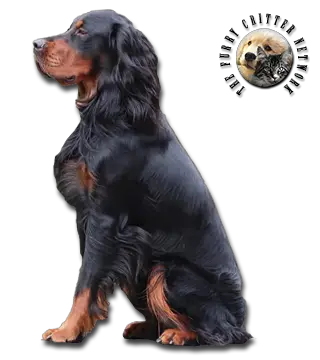Breed Standard
Head: Taller than it is wide, chiseled. Slightly domed skull. Pronounced stop. Long muzzle. Strong jaws. Lips not pendulous. Pink nose.
Ears: set on low,, medium in size, thin, hanging against the head. Long, silky feathering at the tops of the ears.
Eyes: Dark brown.
Body: Medium in length. Brisket not too wide. Chest well let-down. Well-sprung ribs. Short back. Broad, slightly arched loin.
Tail: Thick at the base, tapering to thin tip. Straight or curved loosely in sickle fashion, carried level to the ground. Long, straight feathering (or fringe).
Hair: Short and fine on the head ad front of the legs. Medium in length on the rest of the body. Long, fine, flat feathering on the back of the legs. Feathering on the abdomen.
Coat: Rich, glossy, smoky black on without traces of rust, with tan-markings of a bright reddish-chestnut. Black pencil marks on the toes are allowed, as are black stripes below the jaws. Tan markings: two spots above the eyes, on either side of the muzzle. Two large spots on the chest. Markings on the inside of the hind legs. On the forelegs, tan markings from the feet to the elbows. A small white spot on the chest is allowed.
History
The Gordon Setter was developed in the mid-sixteenth century in Scotland. By the late eighteenth century, the Duke of Gordon had arrived at a breed resembling that of today. Some believe that English and Irish Setters, the Collie, and the Bloodhound were used in developing the Gordon Setter. The first so-called "Black and Tan Scottish Spaniels" were imported to France by 1860. In 1923, a Gordon Setter club was founded. The Gordon Setter is less common than other setters.
Behavior
The AKC describes the Gordon Setter temperament as "alert, interested, and confident. He is fearless and willing, intelligent, and capable. He is loyal and affectionate, and strong-minded enough to stand the rigors of training". Gordons are intensely loyal to their owners; thrive in an attentive, loving environment; and are good family dogs. Puppies and adult dogs can be quite boisterous, and although they are patient by nature, may not be suitable for households with very young children. Gordons are sensitive and empathic, eager to learn, and need firm but gentle handling. Early socialisation and obedience training is important. The breed is one of the slowest to mature, not hitting prime until three years of age or more, and will show puppy-like characteristics well into their older years.
Gordons were bred to run, and require 60 to 80 minutes of vigorous exercise daily. Young dogs should not be over-exercised or begin agility training until they are at least 18 months old, to avoid joint problems later in life. Because of their hunting instincts, Gordons should not be allowed to roam freely if unsupervised, as they are apt to wander into a potentially dangerous traffic situation while following a scent.
He adapts fairly well to city life. He needs space and lots of exercise, as well as regular brushing and attention to the ears and coat.
Function
Hunting Dog, Companion Dog.
Health
Although not as prone to hip dysplasia as many of the larger breeds, Gordons can suffer from the condition. Other health issues can include hypothyroidism, gastric torsion (bloat) and eye diseases such as progressive retinal atrophy (PRA), and cataracts.
At the beginning of 2009, a report was issued to all of the Breed Clubs in the UK concerning cases of late onset PRA in Gordon Setters.
On March 14, 2011, Animal Health Trust (AHT) made a DNA test available. The mutation is termed rcd4 (for rod-cone degeneration 4) to distinguish it from other, previously described forms of rod-cone degeneration. It is recessive, and 19 out of the 21 Gordons in their study who had clinical signs of PRA were homozygous for this mutation, indicating it is the major cause of PRA in the breed.
As many as 50% of Gordon Setters may be carriers.






